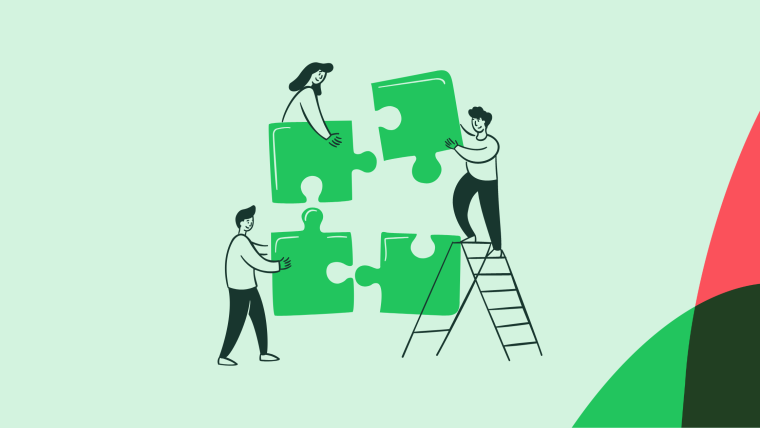Bringing a product to life is not an easy task. From the instant an idea appears in the back of your mind for the first time to the moment your real-life product hits the market, a mysterious and purposeful path unravels before your eyes.
In most cases, the product development process refers to a complex journey that is full of surprises, but be sure that if you carefully think and plan the birth and nurturing of your product you’re much more likely to gain a lot of customers’ thumbs up—which, in a product-led growth-focused companies’ vocabulary—means the magical success of sustainable growth.
What is product development?
First, let’s answer the mother of all questions: what product development actually means.
Sometimes it feels like product development involves everything related to your product's existence and it's difficult to focus on what the product development process really brings to the table as a genuine and distinctive business process. In this sense, we found it useful to distinguish the essential stages of the product development cycle—no matter how diverse the itinerary can be.
Idea generation
Every product development project begins with an idea. It’s obvious to say that not every idea will turn out to be a successful product. There’s a lot of potential ways to come up with a product that makes people’s lives better, a stroke of genius, or careful market research to identify an existing need—but there’s no way you’re going to make it if you don’t check the fit of your product with a real-life base of customers recognizing its value.
Business analysis & Market research
After checking your product solves a real problem and fulfills certain customer needs, you need to calculate how worthy that problem is to solve, as well as if there is a target market for this.
Identify how many potential users or organizations are going to be impacted by it, and to what extent, in order to be willing to pay for it. Take into consideration the efforts needed to bring this product to life, including distribution and escalation. Pain should be smaller than gain.
Concept development
Getting the product concept down is key to a successful product strategy. Here, idea generation translates into definitions of how a product will actually work and serve its purpose through a comprehensive set of features.
Concept testing
Early testing to validate the solution is crucial before diving into more expensive stages like prototyping and design. The product idea lab experiments can be practical or theoretical but they have to meet the requirements to clarify if the product as it was conceptualized will be rejected or lightly adopted.
You could even implement test marketing to see what the customer appetite for your product is like. An example is a fake door test, in which users are invited to try a product that isn't there. In this case, users are usually shown to a waitlist.
Product development planning
We'll describe this stage in-depth later on, and it covers the choice of product development methods and the creation of a master plan with the core definitions to organize the work. It goes side-by-side with the building of the product roadmap (we'll get into this subsequently too).
Minimum viable product development & release
The Minimum Viable Product is the child of lean product development, a product with just enough functionality to be used by customers. Launching this first version of the product allows you to gauge interest, find the best marketing channels, and test your pricing and packaging strategies—among other valuable experiments.
Iteration & Improvement
Now that your product is out there (in its minimalist version), you'll be able to collect user feedback and learn from it to drive continuous product improvements and business expansions. When does this stage end? You've guessed it: never (well, at least not until you need to sunset a feature

Get the Right Features on Your Product Roadmap
Discover how to gather specific feedback that guides your roadmap with microsurveys—check out our on-demand webinar.
Product management vs product development
Now that we’ve seen what’s involved in the product development responsibilities, it’s important to shed light on what product development is not.
It’s common to confuse product development with product management, and also very common to find “A vs. B” perspectives as if product managers and product development teams belong to opposite worlds. The truth is that product development and product management are two different areas of expertise but are deeply intertwined. Identifying both work scopes is relevant for efficient synergy.
A product manager is responsible for setting North Star metrics, aligning collaborative efforts, listening to the market, and optimizing resources to achieve success. Product development is all about building a great product, with product management’s direction.
This doesn’t mean that product development teams—typically constituted by software developers, architects, design, and engineering professionals—are only operational without decision-making power. That couldn't be further from the truth. Purpose and planning are shared, discussed, and agreed upon between both teams, each of them with a particular focus.
Creating your product development plan
Planning your product development process, like in every other complex endeavor, is crucial. There will always be room for flexibility and unexpected shifts, but if your team doesn’t agree and count on a thoughtful route towards your product success, failure is around the corner.
Set your product vision and mission
A product development plan should consider every step of the product’s journey, from idea to market, and define specific requirements and actions needed in each one of them. The plan starts with the product’s vision and mission, with no exceptions. The former provides a clear objective to align every single move of the way, the latter sets the purpose of the product, its potential users, and how it positively impacts their lives (what added value it delivers).
Like a compass, vision and mission are the core guidelines for the rest of the work to sail in a coherent direction and allow the establishment of primary goals. In the early stages, there can be some clouds when it comes to specific objectives (especially with such fast-changing markets as the SaaS industry) but this is why your product development plan is so important: fuzzy goals will become measurable KPIs that will guide data-based decisions around which features and capabilities are the best for your product to achieve them. In other words, you’ll need to adapt your product against key metrics to create the maximum value possible.
Draft the product roadmap
And here’s the point where the product roadmap makes its entrance as the ultimate early-stage planning tool for prioritizing, synthesizing, and stating your product’s main themes and key objectives. Drafting a product roadmap will help your team have a depiction of your high-level product, explicit guidance for executing the strategy, aligning internal efforts, and facilitating communication with external stakeholders. Roadmaps will give you a clear view of where to go, and what to do next. You can have a product roadmap for your product development and also for further specific stages, like the product launch roadmap.

Execute the product development plan
Once the roadmap is ready, it’s showtime. Your product development team should work on schedules and manage each significant product theme in a separate sprint. Each iteration of the product will bring new data and feedback from relevant people inside (Sales, Support, Marketing) and outside the company (investors, advisors, and customers), generating a virtuous circle of roadmap updating, product backlog grooming, and continuous improvement.
Sounds like an odyssey, but it isn’t if you count on your team to collaborate visually and ensure every important perspective is being considered and taken care of.

(Source)
The product development dream team
Product development is collaborative work that goes beyond the product development team itself. For your final product to come to life, you’ll need assistance from Product Management, Sales, Marketing, Operations, Support, and HR—among others. But, without neglecting the overall dynamics, let’s list the members your Product Development Squad requires to win:
Developers and engineers. Hands-on front players, with all eyes on requirements and feature development.
UI/UX designers. User-centric creatives. Holding the voice of the customer while creating user flows, wireframes, and prototypes.
Product designers. Caretakers of how the product should look like to perform and deliver at its best.
Testers. Quality assurance heroes, looking for product weak points, bugs or errors to correct and improve.
Product owners and scrum masters. If you choose an agile product development process, these players will be essential to follow the methodology’s principles.
The product development process
Now that you have the perfect team and your product roadmap properly drafted, it’s time to kick off. But first, you should know that there’s a lot of ways to systematically approach your product development process. Choosing the right framework will give the product development team the proper structure to travel towards the perfect final product. Find below three of the most used options.

A design thinking approach to product development
The Design Thinking framework is one of the most celebrated approaches to foster user-centric innovation and collaboration in very diverse creative environments. This methodology is based on going through the following five steps in an iterative manner, aiming to conquer a seamless outcome.
Step 1: Empathize with users
Empathy is the heart of Design Thinking. Seeking to understand the needs of the users is the first and most important movement towards creating meaningful products or delivering relevant services. During this stage, listening without being judgmental is essential to find useful and unbiased insights about users’ lives and mindsets.
With this goal in mind, shadowing is as important as straight-forward interviewing: to closely observe their behavior (interacting with similar products, for example) without direct intervention as well as putting your hands on tools like surveys or focus groups. Don’t forget that Design Thinking is an iterative methodology and you’ll have to revise this step once your product hits the market. In that case, user onboarding good practices, microsurveys, product tours, and tooltips come in handy to show your empathy with what your customers need when they are interacting with your product.
Step 2: Define the problem
Once you carefully observe and listen, you’ll be able to identify the scope and true nature of the problem your product comes to solve. In this step, the product team defines user types and personas, their objectives per role, the challenges they are dealing with in their daily experiences, and the main pain points encountered.
Step 3: Brainstorm potential solutions
Now it’s time for ideation. In a Design Thinking approach, all ideas are worthy until proven otherwise. Brainstorming and idea-sharing for potential solutions to the problem is key, and divergence comes as convergence’s counterpart. A common method used in this kind of process is “Yes, and…”, where a potential idea is actively nurtured by the team, using the phrase “yes, and…” to keep adding layers of substance to the same project. The goal is to welcome all ideas but also encourage collective construction. Next comes prioritization, when one idea is selected to move to the next phase.
Step 4: Build a prototype
Following on from your potential solutions, prototyping is the moment when your product is shaped. Drafting storyboards and building mockups is part of the deal. The key in this step lies in the expression “keep it simple”, which means your MVP should be the leanest possible. The most important thing is to try courageously, “fail fast” (a design thinking motto to embrace failure as a way of being closer to the perfect product but without forgetting to do it at speed) and iterate quickly.
Step 5: Test your solution
And last but not least, test your heart out. This step goes way beyond quality control, identifying what works and understanding impediments through analysis of the performance and user engagement levels of your product. When you know what’s wrong, change it. How? Going back to step 1. Again, iterate quickly. And don’t forget to empathize with your users once these product changes are released—communicate clearly what has changed in your platform with an in-app feature announcement.
The new product development process (NPD)
The second type of product development process is NPD, and as its name states, it has been designed to bring new product ideas to the market. Like every procedure, it has its variations depending on the type of product and industry, but we can also break it down into the following stages:
Ideation. Much like any innovation process, coming up with a brand new idea can be challenging. But nothing comes from nowhere, some of the best ways to innovate are iterating from existing products (modifications, combinations, reverse engineering, etc.) or deeply analyzing marketplaces.
Research. Once again, product validation is the missing link between a fresh and shiny idea and a successful product idea. Investigate the market, analyze potential competitors, and get feedback from an unbiased audience large enough to be significant.
Planning. Sketch your idea in detail, with multiple features and materials included. Imagine how it would be used and on which occasions. Pricing and packaging should be considered as well. These definitions will later impact your branding and marketing strategy.
Prototyping. Like with the Design Thinking approach, here it’s time to create a finished product to test. It’s very likely you’re going to have more than one version of your product for later improvement by iteration until you find the one.
Sourcing. With your selected prototype ready, you’ll need to find the right resources to make it happen. Sourcing depends a lot on the type of product, from cloud partnerships and software development to materials suppliers, shipping, and warehousing.
Costing. The last step is calculating the total approximate cost of your product to come up with a market price and potential gross margin.
Agile product development—the new kid on the block
In the software development sector, agile methodologies are the leaders of product development processes. Especially in the case of startups that need to be lean and quick to make the most of their limited resources and time to succeed in a very competitive environment, agility came to the rescue.
An agile product development process is managed by cross-functional, self-organizing teams that work collaboratively in iterative cycles. It all starts with a “backlog” of requirements that are later prioritized and divided into groups of items/actions. The work is then treated in iterations called sprints; in each sprint, a piece of the backlog (the group with a higher level of importance) is tackled. Iterations have short timeframes (from one to four weeks) and comprise an entire development cycle (from analysis to testing).
As you can imagine, the best advantage of using an agile framework is that the first (MVP) and later versions of your product are ready faster. Every development cycle is shorter and each release is born with fewer touches. This type of process also makes a continuous improvement approach much more feasible, with incremental changes executed with each and every iteration. Learn more about using Agile Product Development.
Top tips for your product development
With a bigger picture of what product development is all about and a glance at the most useful frameworks to face the challenge, you’re ready to make the product of your dreams come true. Keep these tips in mind as you continue to ship new features:
Be realistic. Most ideas come from abstract and utopian visions, finding how to translate them into the rules of the real world can be frustrating. Overcoming this discouragement is vital for any great product to come to life.
Build a roadmap. Developing a product is a complex journey. If you don’t have a map, you’ll probably get lost. Avoid headaches by organizing and optimizing teamwork with strategic planning.
Believe in your product. Once you validate your idea, fight for it. You’ll find bumps on the road, but there are no bigger assets than resilience and faith in your product development conquest.
Ah, and find yourself the best product team you can get. Like with everything in life, real strength and success only come in collective ways. Now you’re set to develop an unforgettable product. Go get them!

Weekly advice to make your product stick 💌
Be the first to get the latest product best practices and resources




